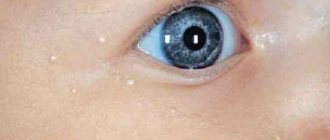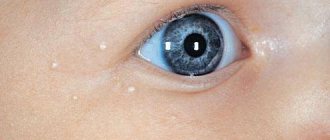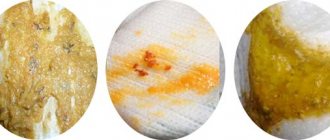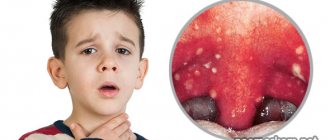How to distinguish milia from other diseases?
- Milia of newborns (note: milia, millet). Signs: affects only newborns, resembles white, very dense acne with a yellowish tint and no more than 2 mm in diameter, located mainly in the nasolabial triangle, on the forehead and cheeks (sometimes partially on the body, chest or neck). Pimples usually look like grains - that’s why the disease is called “millet”. Milia is not accompanied by pain or other symptoms.
- Allergy. As a rule, allergies are accompanied by itching, redness, and capriciousness of the baby. Abnormal bowel movements, lacrimation and other symptoms may also occur.
- Vesiculopustulosis. This inflammation is a consequence of the influence of staphylococci, streptococci or fungi. In newborns it occurs in the absence of proper skin care, in case of infectious diseases in the mother, or in the absence of the necessary sanitary and hygienic conditions in the maternity hospital or at home. Inflammation appears in the form of peas, more often on the head and body than on the face.
- Acne of newborns. We can talk about this phenomenon if the milia have not disappeared 2-3 weeks after their formation. That is, the child’s body could not cope on its own, and a bacterial component appeared. An acne rash also does not seriously threaten your health, but it still needs to be treated. Acne looks like swollen pimples with yellowish tips located on the toddler's face, on the thighs and in the folds of the skin.
- Toxic erythema. This skin reaction is also not dangerous, but in essence resembles an allergy. Outwardly it manifests itself as tiny white pimples on the tummy and chest, although it can appear on the face and even on the limbs.
- Heat rash . One of, perhaps, the most common phenomena in toddlers. External manifestations are small rashes on areas of the skin deprived of full air exchange - red and white in color. As a rule, it occurs due to overheating and high humidity of the skin.
- Thrush . This white rash usually occurs in the mouth, lips, and gums. Among the reasons are dirty nipples, stomatitis, mother's kisses. Causes itching and discomfort and requires treatment.
Causes of white dots
The doctor is in a hurry to reassure new parents that there is no reason for concern in this situation. And he's right. Because this is a common phenomenon that many mothers and fathers have to deal with.
Restructuring of the hormonal system. While the baby was in the womb, nutrition occurred through the umbilical cord connecting the body of mother and child. Some of the maternal hormones entered the baby’s blood. During childbirth, the obstetrician cuts the umbilical cord. Now the baby will receive nutrients through mother's milk.
Hormonal imbalance provokes the appearance of white dots, which most often form on the face. The next reason follows from this.
Excessive amounts of estriol, a female hormone. If an excess amount accumulates in the baby’s body, the internal systems receive a command to remove it, including through the skin pores. These can be single or multiple tiny acne, “scattered” over the baby’s body.
Formation of sebaceous glands. The child's body adapts to life in external conditions. The sebaceous glands are still imperfect and it takes time for them to start working properly. And after the birth of the baby, they can become clogged with excess sebaceous secretions, which look like a white “scattering” on the forehead, cheeks, and wings of the nose.
Milia (milia) are so small that when looking at them, an analogy arises in the mind with tiny grains of sand or sugar crystals. Don't worry about the baby's condition. After a month, the sebaceous glands will be fully formed and the white formations will disappear.
You should not interfere with the natural processes that the child’s body itself regulates. Parents should only monitor his general condition: whether his body temperature has risen, whether he has lost his appetite and sound sleep. It is better not to touch tiny pimples on the face at this time.
How to treat milia?
It should be noted that in this case, medications are not prescribed, and only in rare cases can a pediatrician prescribe certain ointments or solutions with cleansing properties or supporting local immunity.
As for the self-prescription of various creams or drugs with anti-allergenic effects, most often they are simply of no use. And some can even harm the skin and provoke more serious skin manifestations.
- First of all, visit your pediatrician to make sure that it is milia.
- Learn the rules of baby skin care and be patient.
- Do not use medications without a doctor's prescription.
It is important to understand and remember that milia in infants does not require therapy or special drug treatment! But, of course, you need to see a doctor to prevent the inflammatory process.
You should be wary and immediately contact your pediatrician if...
- There are more and more rashes , and the areas of their distribution are becoming wider.
- Pimples begin to change their appearance : they increase in size, change color and contents.
- There are also manifestations of other symptoms . For example, temperature, baby’s discomfort, moodiness, etc.
- The baby has no appetite , is inactive and lethargic.
- Redness, red rashes or spots appear on the body.
With such signs, of course, you cannot do without additional consultation with a doctor.
Remember that these symptoms may hide both an inflammatory process and an allergic reaction, which require immediate treatment!
Why does a rash appear on the face of a newborn?
When a baby is born, many changes occur in his little body. Especially in the first months of life, the body adapts and adapts to its new life and environment. Naturally, during this period, the baby’s parents have questions that they are unable to answer themselves and take action. One of the mysteries for parents is the rash on the baby’s face. So why does a rash appear on the face of a newborn?
The main reasons for the appearance of a rash on the face of a baby
A phenomenon such as a rash on the face of a baby can indicate various consequences and changes in the body. On the one hand, it is the norm for a child, but on the other, it indicates a serious illness. Only a doctor should and can determine the cause and make a conclusion. Of course, everyone knows that nowadays, if you go online, you will find a description of the rashes, their types and photos, but you will only receive the correct diagnosis from a doctor after the diagnosis has been completed.
So, what can you say about a rash on a baby's face? It may appear on the chin, forehead, around the mouth and on the cheeks. This depends on the structure of the baby’s skin, for example, where the number of sweat and sebaceous glands is greater, the likelihood of a rash is also greater. In some cases, the rash may spread beyond the face, namely to the neck and body. The causes of facial rash in newborns may depend on various factors.
Allergy
Most often, in infants, a rash that appears on the face indicates an allergic reaction. In this case, the child becomes restless, as the pimples itch and the skin around them becomes very itchy. In order not to disrupt the functioning of children's immunity, it is necessary to identify and eliminate the allergen as quickly as possible. There are several factors that most often cause allergies in infants:
- medicines;
- food diathesis;
- poor nutrition;
- household chemicals;
- synthetic clothing;
- insect bites;
- inhalation of floral odors;
- sudden change in weather, etc.
Milia in infants
Often, a rash on a baby’s face is a physiological norm. For example, if in the third week after birth, white and painless nodules appeared on the baby’s face. Parents should not panic - these are ordinary milia or they are also called “whiteheads”. This is the process of activation of the child’s sebaceous glands by mother’s hormones. During this period, sebum accumulates in the ducts of newborns. They do not need to be treated or squeezed out, as they can subsequently harm the child’s health. The rash goes away on its own within a few weeks.
What to remember?
- While you are breastfeeding, keep a food diary to know what your baby reacted to if an allergy does appear.
- Eat foods that are less fatty and allergenic.
- Do not introduce new foods during treatment.
- Do not eat sweets with chemical additives.
And - be patient. If the baby’s body is not overloaded, then very soon all its systems will mature, and such problems will remain only in memories.
The site Colady.ru warns: the information is provided for informational purposes only and does not constitute medical advice. Do not self-medicate under any circumstances!
If you have any problems with your baby's health, consult your doctor!
White dots on the face of a newborn - what are they?
Good afternoon, young parents! Today we will talk about white dots on the face of a newborn - what are they? When parents first experience the joy of a new person coming into this world, whom they had already fallen in love with when he was still living and developing in the womb, they still do not know how many difficulties and new discoveries await them ahead.
The first feeding, the first diaper change and other joyful moments of caring for a child - all this causes conflicting feelings in mothers.
On the one hand, the woman feels her heart overflowing with love for the baby and the desire to take care of the baby, and on the other hand, they feel a painful fear that they will cause the child some kind of pain. There will be many more such fears.
One of the reasons for parents' concern and concerns about the baby's health is white spots on the face of the newborn.
- Is it worth worrying and sounding the alarm about this?
- Where do these whiteheads come from and how to treat them?
You will find answers to these questions and some more useful information in this article.
What could be the reason for the appearance of white dots on the face of a newborn?
If we are talking about milliae - white dots on the face of babies who have just been born, then there is nothing scary about it. These are rashes that about 80% of parents experience.
But, also, these can be other types of pimples, which even in some cases require treatment. The reasons for the appearance of white dots on the face of a newborn can be different.
Here is a list of the most common reasons:
- A large amount of maternal hormones in the baby’s body.
- Imperfect functioning of the sebaceous glands.
- Adaptive reaction of infant skin.
- Infection.
Hormonal pimples – (blooming)
Quite often, newborns on the 3-7th day of life appear white dots on the face, which from time to time become inflamed, turn red and can even spread to the head. In principle, there is nothing wrong with this, and such rashes do not require special treatment.
The most important thing in this case is to strictly observe hygiene measures; immediately before contact with the child’s skin, you need to wash your hands and use an antiseptic.
Remember - wet wipes cannot replace proper hand washing.
Imperfect functioning of the sebaceous glands
Pores can become clogged due to increased work of the glands, since all babies are born with an underdeveloped system of sweat and sebaceous glands.
In general, the exocrine secretion system will improve during the first three months, and in the first month of life these processes occur much faster and more intensely. Such pimples will go away without any intervention, and by the way, very quickly.
But if such pimples spread or increase in size and do not go away completely in the first month of life, then it is imperative to show the baby to a dermatologist.
Adaptation rash in newborns
Do not forget that childbirth is a huge stress not only for the mother, but first of all for the baby, who also goes through a difficult period of adaptation after it. The baby needs to learn to eat independently, get used to the fact that you need to breathe air, and also learn to live not in amniotic fluid, but in a new, airy environment.
That is why small pimples sometimes appear on the skin, which, in principle, do not bother the baby. Pimples can look not only like white dots on the face of a newborn, but also reddish - in this case there is no reason for parents to worry.
They appear, as a rule, already on the second or third day after birth. But, if you are still worried and in doubt, then show the baby to a neonatologist, at least for your peace of mind.
Infectious rash in newborns
This type of pimples in newborns is the most dangerous. You need to sound the alarm from the very beginning, because in this case every hour is decisive, and the sooner you start treatment, the greater the likelihood that you will be able to avoid complications.
If the appearance of white spots on the face of a newborn is caused by an infection, the doctor should prescribe appropriate treatment. In this case, small white pimples quickly become inflamed and can appear around the anus, around the eyes and in the mouth.
To determine what type of bacteria caused the white spots on the newborn’s face, it is necessary to have the pimple scraped for analysis. Under no circumstances should you do this yourself; perhaps you are dealing with benign formations - then any intervention carries the threat of spreading and causing a secondary infection.
Useful tips for parents on caring for their children's skin when whiteheads appear
If you notice any changes in the skin, rash or peeling in your newborn baby, the first thing to do is calm down and don’t panic! Ideal newborn babies with the purest peach skin exist only in Photoshop.
Therefore, there is no need to be afraid that something terrible is happening to your baby. This is only a temporary phenomenon, which, with proper care, will pass very quickly. But, you are able to speed up the process of cleansing your baby’s skin, so arm yourself with tips and act.
- Be sure to consult with your doctor before concluding that your child's pimples are not dangerous and do not require additional treatment.
- Wash your baby daily - twice a day, morning and evening. For washing, use only warm boiled water or saline solution. Under no circumstances should you wash your baby with raw or artesian water - there are a lot of bacteria and salts there that will negatively affect the condition of delicate skin.
- In principle, you can also use herbal decoctions for washing, but when choosing a specific plant, be sure to consult your doctor.
- Never treat whiteheads on your newborn's face with alcohol, hydrogen peroxide, or any alcohol-based lotion. Baby skin is too delicate and you can burn it very easily.
- Do not squeeze or tear off the white dots - this will not speed up recovery, it can only cause infection.
- Make sure that the baby does not pick off these pimples, and trim his nails on time.
- Do not use any rash or acne treatment that is intended for adults. The skin of an adult and a newborn is very different.
White dots on the face of a newborn are considered to be a sign of early infancy, don’t worry!
Video - how to distinguish pimples and spots from allergies
Let's look at useful baby care products:
We wish your family health and happiness!
Did you like the article? Share with friends on social networks:
sosed-domosed.ru








